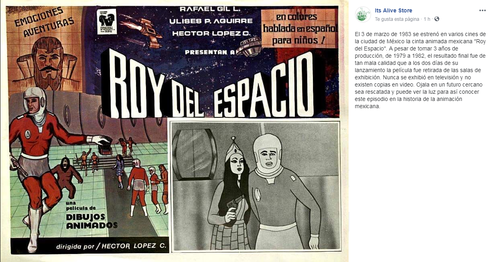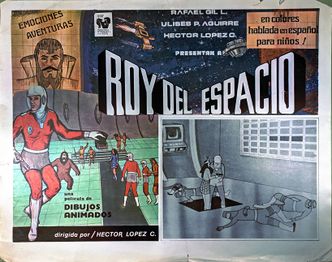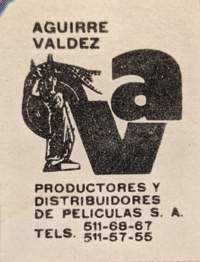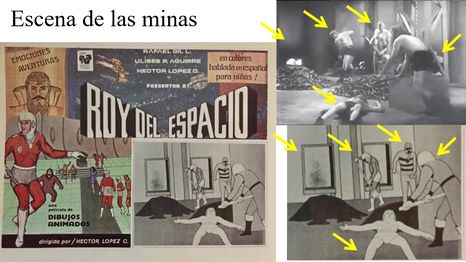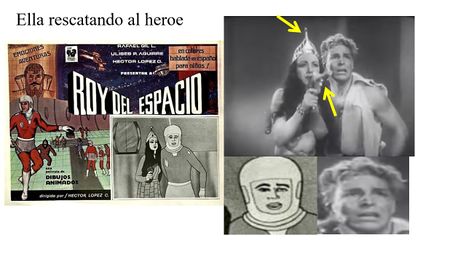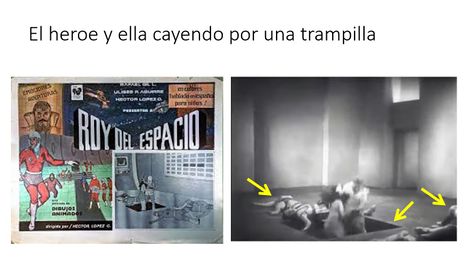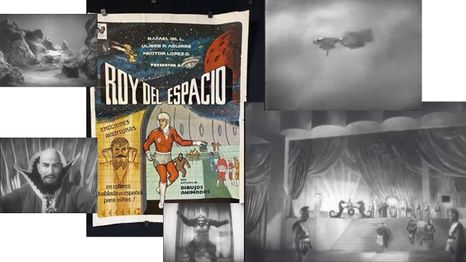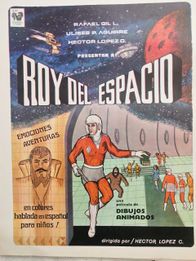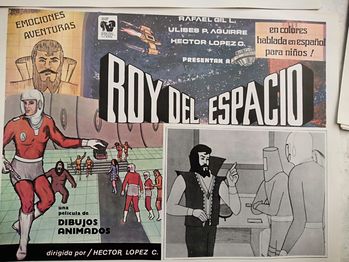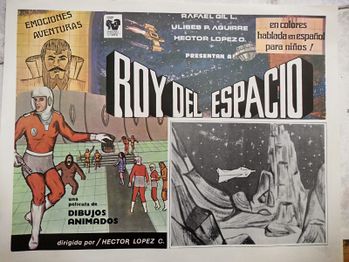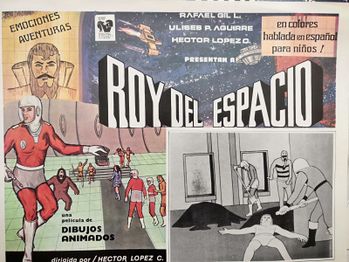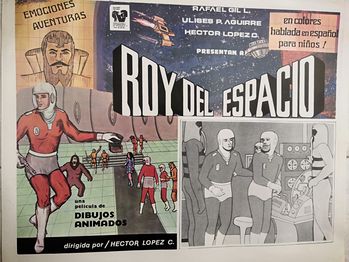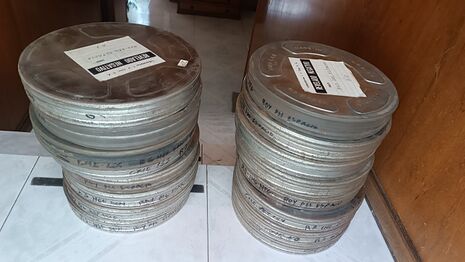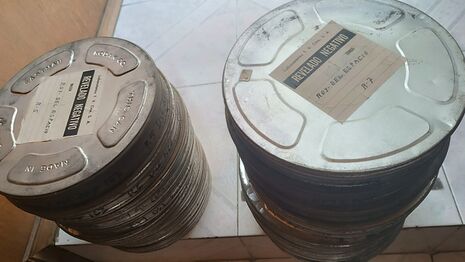Roy del Espacio (lost Mexican animated film; 1983): Difference between revisions
Donrodrigo63 (talk | contribs) |
Donrodrigo63 (talk | contribs) No edit summary |
||
| (22 intermediate revisions by the same user not shown) | |||
| Line 6: | Line 6: | ||
}} | }} | ||
'''''Roy Del Espacio''''' (aka '''''Roy From Space''''') was a Mexican animated movie directed by Hector Lopez Carmona, Rafael Angel Gil and Ulises P. Aguirre that was produced from 1979 to 1982, being released in twelve theaters in Mexico City on March 3rd, 1983.<ref>Amador, M., L. & Ayala Blanco, J. (2006). ''[https://books.google.com.co/books?id=XLxBcHacjkAC&printsec=frontcover&source=gbs_ge_summary_r&cad=0#v=onepage&q=roy%20del%20espacio&f=false Cartelera Cinematográfica 1980-1989]''. Universidad Nacional Autónoma de México.</ref> It was the third Mexican animated feature film made. The online information about Carmona and Gil is nonexistent, but Perez Aguirre is the only one who has credits as producer and writer of several movies. Aguirre was involved in sex comedies and low-budget exploitation films during the eighties, as IMDb shows. Though there is not biographical information about him online, Andy, his daughter, confirmed Pérez Aguirre died in 1997 after a long illness.<ref name=":0">Phone interview with Andy, Ulises Pérez Aguirre's daughter, done on October 18, 2021 by Donrodrigo63 (Alejandro Vidal Charris).</ref> The scarce plot details found on the ''Anuario Cinematográfico 84'' (Cinematographic Yearbook 84), edited by the National Autonomous University of Mexico Film Archive (Filmoteca UNAM) and published in 1984, go as follow: Alome, emperor of a distant red planet, threatens to destroy Earth. Roy, Dr. Faz and psychologist Elena are sent by Earth leaders in a peace mission to this planet, but they get involved in a series of adventures that include romance, robot fights and space battles. According to information from Cineteca Nacional, the movie had a runtime of 63 minutes. | '''''Roy Del Espacio''''' (aka '''''Roy From Space''''') was a Mexican animated movie directed by Hector Lopez Carmona, Rafael Angel Gil and Ulises P. Aguirre that was produced from 1979 to 1982, being released in twelve theaters in Mexico City on March 3rd, 1983.<ref>Amador, M., L. & Ayala Blanco, J. (2006). ''[https://books.google.com.co/books?id=XLxBcHacjkAC&printsec=frontcover&source=gbs_ge_summary_r&cad=0#v=onepage&q=roy%20del%20espacio&f=false Cartelera Cinematográfica 1980-1989]''. Universidad Nacional Autónoma de México.</ref> It was the third Mexican animated feature film made. The online information about Carmona and Gil is nonexistent, but Perez Aguirre is the only one who has credits as producer and writer of several movies. Aguirre was involved in sex comedies and low-budget exploitation films during the eighties, as IMDb shows. Though there is not biographical information about him online, Andy, his daughter, confirmed Pérez Aguirre died in 1997 after a long illness.<ref name=":0">Phone interview with Andy, Ulises Pérez Aguirre's daughter, done on October 18, 2021 by Donrodrigo63 (Alejandro Vidal Charris).</ref> The scarce plot details found on the ''Anuario Cinematográfico 84'' (Cinematographic Yearbook 84), edited by the National Autonomous University of Mexico Film Archive (Filmoteca UNAM) and published in 1984, go as follow: Alome, emperor of a distant red planet, threatens to destroy Earth. Roy, Dr. Faz and psychologist Elena are sent by Earth leaders in a peace mission to this planet, but they get involved in a series of adventures that include romance, robot fights and space battles. According to information from Cineteca Nacional, the movie had a runtime of 63 minutes. | ||
== Synopsis == | |||
The book ''Historia de la producción cinematográfica mexicana, 1979-1980'' (History of Mexican cinematographic production, 1979-1980) contains a thoroughly detailed plot summary of the film (pp. 175-176). This summary is also available on IMDb:<ref name=":2">Vargas, J. C. (2008). Roy del Espacio. In E. de la Vega (Coord.), ''Historia de la producción cinematográfica mexicana 1979-1980'' (pp. 175-176). Universidad de Guadalajara.</ref><blockquote>"Mars irradiates cosmic emanations to Earth. At UNO headquarters, scientists from France, Italy and the United States meet to deal with the problem and they send Roy, the world's best astronaut, to investigate. He is accompanied by Dr. Faz and psychologist Helena. Upon arriving to Mars, Roy and his friends are caught by King Alom's robots, a tyrant who wishes Faz and Helena work for him. Roy fights off the robots and escapes with the aid of the Princess, Alom's daughter. Roy takes over a spaceship and destroys other two ones that were approaching. From one of those ships emerges Prince Leo, who joins forces with Roy to defeat King Alom. Alom tries to brainwash Helena to make her his queen. Roy and Prince Leo disrupt the wedding and rescue Helena. The Princess confesses her love to Roy. The falcon men, Prince Trax's servants, kidnap Helena and take her to their planet. Roy, Prince Leo, the Princess and Faz go to rescue her with another ally, Prince Trix. The group is uncovered by Prince Trax, who sends Roy, Trix and Leo to forced labor at his nuclear furnaces. Faz is forced to work in Trax's experiments. King Alom comes for his daughter. With the help of Roy, Leo and Trix, Faz manages to cause an explosion at the furnaces and offers to save the colony in exchange for his freedom. To release them, King Alom demands Roy to defeat a cyclops. Roy kills it with the aid of the Princess, who at the same time helps a robot. Leo returns to his world. Back in Mars, Alom hinders Helena, Roy and Faz' departure with the excuse of throwing a celebration for them. The robot offers the Princess amnesia pills to give them to Roy, so he can forget Helena. Trix, Trax and Faz help him to regain his memory back. Shortly after, Alom orders the murder of Roy, but Faz makes him invisible. Roy takes advantage of his condition to attack Alom and his robots. Out of jealousy, the Princess makes a wild beast attack Helena, however is saved by Roy. Leo and his men raid the place. King Alom runs off. Roy declares his love to the Princess and both depart on a ship, but the robot alters the route of their trip to the infinite."</blockquote> | |||
==Production== | ==Production== | ||
| Line 11: | Line 14: | ||
Ignacio "Nacho" Renteria, a veteran animator, and the only known professional artist who worked in the movie, gives a detailed account of the particular conditions in which it was produced. His testimony quoted in the book ''El Episodio Perdido: historia del cine mexicano de animación'' (The Lost Episode: History of Mexican Animated Cinema), written by historian Juan Manuel Aurrecoechea and published by Cineteca Nacional in 2004, proves the production process was troubled by lack of experience and overall carelessness: <blockquote>"Hector Lopez, who was a great professional in his field, wanted to make an animated film according to his own ideas. He made makeshift projection mechanisms on the light boxes so some girls could copy an old space travel film frame by frame. Those were girls with no experience at all, hired through newspaper ads. "For such a simple thing, I don't need professionals," said Lopez. It was a painful task. It did not work, the girls could only trace the center of each frame, because the projection on the edges was too blurry. I was the only animator, but he was inflexible, he didn't accept any suggestions. My profession meant very little to him, because he thought I should make two hundred drawings a day when I only was making twenty. When I told him about exposure sheets, he said: "Look, you are the animator, and I am the photographer, so don't talk to me about exposure". It was devastating to me. However, he was an honest man, and he paid me timely, but when I got a better job, I quit."</blockquote> Renteria also said that the paper used for the drawings was tissue paper, instead of the conventionally used bond paper. Moreover, there was not much attention to details, since Renteria tells at times he had problems trying to determine if Roy was holding a gun or another type of weapon, or even if the spaceship that arrived to a place in one scene was the same that departed during the previous one. These accounts confirm the movie was crudely rotoscopied, plagiarizing real-action Flash Gordon movies from the 1936 serial.<ref>[http://web.archive.org/web/20091031003037/http://animacionenmexico.blogspot.com/2008/04/iniciadores-de-la-animacin-en-mxico.html ''Iniciadores de la animación en México: Nacho Rentería. Animación Mexicana (Blog)''] Retrieved 04 Jul '21</ref> In April 2022, user Agustín K., from the Fandom platform, was able to determine the Flash Gordon movies used for the animation, which were the three first episodes from the serial: ''The Planet of Peril, The Tunnel of Terror'' and ''Captured by Shark Men.'' Starting from the few extant lobby cards, he could find the exact plagiarized scenes. They can be seen in the gallery of this article. | Ignacio "Nacho" Renteria, a veteran animator, and the only known professional artist who worked in the movie, gives a detailed account of the particular conditions in which it was produced. His testimony quoted in the book ''El Episodio Perdido: historia del cine mexicano de animación'' (The Lost Episode: History of Mexican Animated Cinema), written by historian Juan Manuel Aurrecoechea and published by Cineteca Nacional in 2004, proves the production process was troubled by lack of experience and overall carelessness: <blockquote>"Hector Lopez, who was a great professional in his field, wanted to make an animated film according to his own ideas. He made makeshift projection mechanisms on the light boxes so some girls could copy an old space travel film frame by frame. Those were girls with no experience at all, hired through newspaper ads. "For such a simple thing, I don't need professionals," said Lopez. It was a painful task. It did not work, the girls could only trace the center of each frame, because the projection on the edges was too blurry. I was the only animator, but he was inflexible, he didn't accept any suggestions. My profession meant very little to him, because he thought I should make two hundred drawings a day when I only was making twenty. When I told him about exposure sheets, he said: "Look, you are the animator, and I am the photographer, so don't talk to me about exposure". It was devastating to me. However, he was an honest man, and he paid me timely, but when I got a better job, I quit."</blockquote> Renteria also said that the paper used for the drawings was tissue paper, instead of the conventionally used bond paper. Moreover, there was not much attention to details, since Renteria tells at times he had problems trying to determine if Roy was holding a gun or another type of weapon, or even if the spaceship that arrived to a place in one scene was the same that departed during the previous one. These accounts confirm the movie was crudely rotoscopied, plagiarizing real-action Flash Gordon movies from the 1936 serial.<ref>[http://web.archive.org/web/20091031003037/http://animacionenmexico.blogspot.com/2008/04/iniciadores-de-la-animacin-en-mxico.html ''Iniciadores de la animación en México: Nacho Rentería. Animación Mexicana (Blog)''] Retrieved 04 Jul '21</ref> In April 2022, user Agustín K., from the Fandom platform, was able to determine the Flash Gordon movies used for the animation, which were the three first episodes from the serial: ''The Planet of Peril, The Tunnel of Terror'' and ''Captured by Shark Men.'' Starting from the few extant lobby cards, he could find the exact plagiarized scenes. They can be seen in the gallery of this article. | ||
Besides ''Flash Gordon,'' shots from another sci-fi movie were used without permission. According to Vargas (2008: 176), there were two scenes in which "sophisticated spaceships from some Hollywood science-fiction production"<ref name=":2" /> make their appearance. According to the author, it is very likely that such footage was taken from ''Battlestar Galactica'' (1979), a film which condensed several episodes from the popular TV series. There is no way to verify this, since on the credits no information is given about the source of these scenes. | |||
In addition to these details, Andy, Pérez Aguirre's daughter, revealed that she and several of her cousins participated in the design of backgrounds, coloring and character drawing when they were all teenagers, thus making the production process a trivial experience for all the involved. According to her, the project in general was the result of a "whim" of her father and Héctor López, who had been great friends since childhood and wanted to produce the movie with no intention to make a profit, and to see "what would happen"<ref name=":0" /> | In addition to these details, Andy, Pérez Aguirre's daughter, revealed that she and several of her cousins participated in the design of backgrounds, coloring and character drawing when they were all teenagers, thus making the production process a trivial experience for all the involved. According to her, the project in general was the result of a "whim" of her father and Héctor López, who had been great friends since childhood and wanted to produce the movie with no intention to make a profit, and to see "what would happen"<ref name=":0" /> | ||
==Premiere == | ==Premiere == | ||
''Roy del Espacio'' was finally premiered on March 3, 1983 in twelve cinemas from Mexico City, a good amount of theaters for a Mexican movie at the time. Despite this, the final result was of really poor quality, so much that the movie was pulled from ten of those twelve theaters, only two days after its premiere. The other two remaining ones played the movie for one more week.<ref name=":1" /> Fernando Ruiz, another renowned animator, and one of the very few people who actually managed to see the movie, | ''Roy del Espacio'' was finally premiered on March 3, 1983 in twelve cinemas from Mexico City, a good amount of theaters for a Mexican movie at the time. Despite this, the final result was of really poor quality, so much that the movie was pulled from ten of those twelve theaters, only two days after its premiere. The other two remaining ones played the movie for one more week.<ref name=":1" /> Fernando Ruiz, another renowned Mexican animator, and one of the very few people who actually managed to see the movie, made this remark twenty years after the premiere: ''"we were five people in the theater. But after a while, I was the only person there, and I was forced to stay because I work as an animator"''.<ref name=":1" /> After this short-lived screening time, no other exhibition attempts were heard of. The movie was never broadcast on TV nor released on home video. | ||
In October 2021, and thanks to the efforts of users Alexch1928 (Donrodrigo63 on this site) and Paco Cifuentes, from the Spanish-speaking version of the LMW (on the Fandom platform), it was confirmed that the original film negatives | In October 2021, and thanks to the efforts of users Alexch1928 (Donrodrigo63 on this site) and Paco Cifuentes, from the Spanish-speaking version of the LMW (on the Fandom platform), it was confirmed that the original film negatives are still stored at Cineteca Nacional de México. However, Pérez Aguirre's widow is the rights owner of this material and the only person who can give authorization to release or transfer the movie to other formats. No agreement has been reached regarding any possible digitalization of the film, keeping it inaccessible for the time being.<ref name=":0" /> | ||
==Mentions== | ==Mentions== | ||
The movie has been mentioned or reviewed in five books throughout these years. The first mention was made in ''Anuario Cinematográfico 84'' (Cinematographic Yearbook 84).<ref>Pérez Turrent, T. (Coord.). (1984). ''Anuario Cinematográfico 84''. Filmoteca UNAM</ref>. The book has a synopsis, which is quoted at the beginning of this article. The second reference can be found in the book ''La Guía del Cine Mexicano: de la pantalla grande a la televisión, 1919-1984'' (The Mexican Cinema Guide: from the big screen to TV), published in 1984. This work contains what seems to be the only review of the movie written shortly after its premiere, as all the other commentaries were published during the 2000s. It's worth noting that the authors mistakenly claim that ''Roy'' was the fourth animated movie ever made in Mexico (p. 269):<ref>García Riera, E., & Macotela, F. (1984). ''La Guía del Cine Mexicano: de la pantalla grande a la televisión, 1919-1984.'' México D.F.: Editorial Patria</ref><blockquote>"Animated feature film, the fourth ever made in the history of Mexican cinema. It deals with a science fiction theme and is moderately suitable for children, in spite of its obvious technical flaws."</blockquote>The third reference can be found in the book ''El Episodio Perdido'', which has been quoted throughout this article.<ref name=":1">Aurrecoechea, J. M. (2004). ''El episodio perdido: Historia del cine mexicano de animación''. Cineteca Nacional</ref> Aurrecoechea again quotes Fernando Ruiz's account, describing the film as ''"an extravagance, a daring experiment and (…) an absolute disaster"''. The fourth reference is part of ''El Futuro más Acá: Cine mexicano de Ciencia Ficción'', a book edited by Itala Schmelz and published by CONACULTA in 2006. The only two lines referring to the movie state that the producers of the flim wanted to publish a comic based on the character, but this never happened (p. 262).<ref>Schmelz, I. (Coord.). (2006). ''El Futuro más Acá: Cine mexicano de Ciencia Ficción''. CONACULTA</ref> | |||
Finally, the book ''Historia de la producción cinematográfica mexicana, 1979-1980,'' coordinated by Eduardo de la Vega Alfaro and published in 2008, has a very comprehensive review of the film, the most complete available so far. The commentary, written by Juan Carlos Vargas, does not spare adjectives to describe the film, and it highlights the particularly poor animation work (p.176):<ref name=":2" /><blockquote>"''Roy del espacio'' looks like a school project made of crude drawings in which neither the characters nor the backgrounds are clearly drawn. There is no depth of field and the movement of the figures in the space that surrounds them is not credible. Due to this, Roy and the rest of the characters move like cardboard puppets, clumsily and slowly, and they also give the impression of being floating all the time. In the technical aspect, the film is thus a nonentity."</blockquote>The story does not make up for the mediocre animation, since the screenplay is | |||
<blockquote>"unimaginative, bland, incoherent and repetitive, lacking any hint of interest. Everything revolves around characters falling in love at first sight and a succession of yawn-inducing fights."<ref name=":2" /> </blockquote> | |||
==Alternative Material Found== | ==Alternative Material Found== | ||
In December 2020, an alternative poster (sold in June 2021) from the movie was listed on [https://web.archive.org/web/20210603000346/https://www.ebay.com/itm/1983-ROY-DEL-ESPACIO-Rafael-Gil-Original-Mexican-Movie-Poster-27-5-x37-/333822981800 Ebay]. This poster does not have any movie still as the other one shown on this page. Regarding the origin of the item, the seller claims it comes from a "regional film archive in Mexico that had serviced 20 theaters for 50 years from the 1930s to the 1980s". It also shows on the left top corner the logo of the distribution company, Aguirre Valdez Productores y Distribuidores de Películas S.A. (which has been defunct since long ago, according to Pérez Aguirre's daughter), along with the contact information. In September 2021, a new lobby card was sent by Reddit user u/benritter2 to | In December 2020, an alternative poster (sold in June 2021) from the movie was listed on [https://web.archive.org/web/20210603000346/https://www.ebay.com/itm/1983-ROY-DEL-ESPACIO-Rafael-Gil-Original-Mexican-Movie-Poster-27-5-x37-/333822981800 Ebay]. This poster does not have any movie still as the other one shown on this page. Regarding the origin of the item, the seller claims it comes from a "regional film archive in Mexico that had serviced 20 theaters for 50 years from the 1930s to the 1980s". It also shows on the left top corner the logo of the distribution company, Aguirre Valdez Productores y Distribuidores de Películas S.A. (which has been defunct since long ago, according to Pérez Aguirre's daughter), along with the contact information. In September 2021, a new lobby card was sent by Reddit user u/benritter2 to user u/Modern_harpsichord on account of a post about the movie. Benritter2 said he bought this poster on eBay in 2010, approximately, but he had no further information about the film.<ref>[https://www.reddit.com/r/lostmedia/comments/prk393/roy_del_espacio_1983_lost_mexican_animated_movie/ ''Roy del Espacio (1983, lost Mexican animated movie) - Second post. Reddit''] Retrieved 25 Sep '21</ref> This lobby card is identical to the one that illustrates this article, but it has a different still. In June 2022, Pérez Aguirre's daughter contacted user Donrodrigo63 and sent him via WhatsApp a collection of hitherto unavailable five lobby cards, which came from her father's private archive. In August 2024, Pérez Aguirre's daughter shared with the main editor of this article some photos that show the canisters that contain the original camera negatives. Those photos are included in this article. | ||
Currently, there are | Currently, there are seven lobby cards available, all of them containing both original art and black-and-white stills. Those cards, and the full-sized poster, are so far the only visual information of any kind available from the movie, as any color still, trailer or fragment has yet to surface. | ||
==Gallery== | ==Gallery== | ||
<gallery mode="packed" heights=" | <gallery mode="packed" heights="175"> | ||
File:Roy its alive.png|Original Facebook post from It's Alive Store, containing info from the movie. | |||
Roy.jpg|The alternate poster as it has been listed on eBay. | File:Roy.jpg|The alternate poster as it has been listed on eBay. | ||
Roy del Espacio - lobby card.jpeg|Lobby card containing a different black and white still. | File:Roy del Espacio - lobby card.jpeg|Lobby card containing a different black and white still. | ||
Roy del Espacio - Still from lobby card.jpg|Another still of the movie. | File:Roy del Espacio - Still from lobby card.jpg|Another still of the movie. | ||
Aguirre Valdez logo.png|The logo of Aguirre Valdez Productores y Distribuidores de Películas S.A. | File:Aguirre Valdez logo.png|The logo of Aguirre Valdez Productores y Distribuidores de Películas S.A. | ||
File:Comparativa Roy del Espacio - Flash Gordon 1.jpg|Still comparison between ''Roy del Espacio'' and ''Flash Gordon''. Mine scene. Courtesy of '''Agustín K'''. | |||
Comparativa Roy del Espacio - Flash Gordon 1.jpg|Still comparison between Roy del Espacio and Flash Gordon. Mine scene. Courtesy of Agustín K. | File:Comparativa Roy del Espacio - Flash Gordon 2.jpg|The princess rescuing the hero. | ||
Comparativa Roy del Espacio - Flash Gordon 2.jpg|The princess rescuing the hero. | File:Comparativa Roy del Espacio - Flash Gordon 3.jpg|The hero and the princess falling through a trapdoor. | ||
Comparativa Roy del Espacio - Flash Gordon 3.jpg|The hero and the princess falling through a trapdoor. | File:Comparativa Roy del Espacio - Flash Gordon 4.jpg | ||
Comparativa Roy del Espacio - Flash Gordon 4.jpg| | File:Roy window card.jpeg | ||
File:Roy del Espacio lobby card 1.jpeg | |||
File:Roy del Espacio lobby card 2.jpeg | |||
File:Roy del Espacio lobby card 3.jpeg | |||
File:Roy del Espacio lobby card 4.jpeg | |||
File:Roy del Espacio lobby card 5.jpeg | |||
File:Latas negativos Roy del Espacio 1.jpg|Film canisters that contain the original camera negatives. Courtesy of Ulises Pérez Aguirre's daughter. | |||
File:Latas negativos Roy del Espacio 2.jpg | |||
</gallery> | </gallery> | ||
==External Links== | ==External Links== | ||
*[https://www.imdb.com/name/nm0701829/ IMDb page on ''Ulises Pérez Aguirre''.] | *[https://www.imdb.com/name/nm0701829/ IMDb page on ''Ulises Pérez Aguirre''.] | ||
*[https://www.imdb.com/title/tt0342947/ IMDb page on ''Roy del Espacio''.] | |||
==References== | ==References== | ||
Latest revision as of 14:22, 15 September 2024
Roy Del Espacio (aka Roy From Space) was a Mexican animated movie directed by Hector Lopez Carmona, Rafael Angel Gil and Ulises P. Aguirre that was produced from 1979 to 1982, being released in twelve theaters in Mexico City on March 3rd, 1983.[1] It was the third Mexican animated feature film made. The online information about Carmona and Gil is nonexistent, but Perez Aguirre is the only one who has credits as producer and writer of several movies. Aguirre was involved in sex comedies and low-budget exploitation films during the eighties, as IMDb shows. Though there is not biographical information about him online, Andy, his daughter, confirmed Pérez Aguirre died in 1997 after a long illness.[2] The scarce plot details found on the Anuario Cinematográfico 84 (Cinematographic Yearbook 84), edited by the National Autonomous University of Mexico Film Archive (Filmoteca UNAM) and published in 1984, go as follow: Alome, emperor of a distant red planet, threatens to destroy Earth. Roy, Dr. Faz and psychologist Elena are sent by Earth leaders in a peace mission to this planet, but they get involved in a series of adventures that include romance, robot fights and space battles. According to information from Cineteca Nacional, the movie had a runtime of 63 minutes.
Synopsis
The book Historia de la producción cinematográfica mexicana, 1979-1980 (History of Mexican cinematographic production, 1979-1980) contains a thoroughly detailed plot summary of the film (pp. 175-176). This summary is also available on IMDb:[3]
"Mars irradiates cosmic emanations to Earth. At UNO headquarters, scientists from France, Italy and the United States meet to deal with the problem and they send Roy, the world's best astronaut, to investigate. He is accompanied by Dr. Faz and psychologist Helena. Upon arriving to Mars, Roy and his friends are caught by King Alom's robots, a tyrant who wishes Faz and Helena work for him. Roy fights off the robots and escapes with the aid of the Princess, Alom's daughter. Roy takes over a spaceship and destroys other two ones that were approaching. From one of those ships emerges Prince Leo, who joins forces with Roy to defeat King Alom. Alom tries to brainwash Helena to make her his queen. Roy and Prince Leo disrupt the wedding and rescue Helena. The Princess confesses her love to Roy. The falcon men, Prince Trax's servants, kidnap Helena and take her to their planet. Roy, Prince Leo, the Princess and Faz go to rescue her with another ally, Prince Trix. The group is uncovered by Prince Trax, who sends Roy, Trix and Leo to forced labor at his nuclear furnaces. Faz is forced to work in Trax's experiments. King Alom comes for his daughter. With the help of Roy, Leo and Trix, Faz manages to cause an explosion at the furnaces and offers to save the colony in exchange for his freedom. To release them, King Alom demands Roy to defeat a cyclops. Roy kills it with the aid of the Princess, who at the same time helps a robot. Leo returns to his world. Back in Mars, Alom hinders Helena, Roy and Faz' departure with the excuse of throwing a celebration for them. The robot offers the Princess amnesia pills to give them to Roy, so he can forget Helena. Trix, Trax and Faz help him to regain his memory back. Shortly after, Alom orders the murder of Roy, but Faz makes him invisible. Roy takes advantage of his condition to attack Alom and his robots. Out of jealousy, the Princess makes a wild beast attack Helena, however is saved by Roy. Leo and his men raid the place. King Alom runs off. Roy declares his love to the Princess and both depart on a ship, but the robot alters the route of their trip to the infinite."
Production
While many of the details of the production still remain unknown, thanks to a Reddit thread on r/mexico,[4] where users Modern_harpsichord and Escilas compiled several sources, it is possible to know some details about the production process of the movie. The director, Hector Lopez Carmona, has been described as unprofessional and unskilled, since he had plenty of experience as cameraman, but none as an animator. Carmona was a technician who belonged to the STIC (Sindicato de Trabajadores de la Industria Cinematográfica, Union of Workers of the Cinematographic Industry). He had a long career making titles for newsreels, but he had neither animation knowledge nor experience.[5] Finally, about Aguirre Valdez Productores y Distribuidores, (according to the legal authorization for commercial exhibition, included in file A-01421, located at the Cineteca Nacional de México) it is known that it had its headquarters at Avenida Chapultepec No. 428, in Mexico City.
Ignacio "Nacho" Renteria, a veteran animator, and the only known professional artist who worked in the movie, gives a detailed account of the particular conditions in which it was produced. His testimony quoted in the book El Episodio Perdido: historia del cine mexicano de animación (The Lost Episode: History of Mexican Animated Cinema), written by historian Juan Manuel Aurrecoechea and published by Cineteca Nacional in 2004, proves the production process was troubled by lack of experience and overall carelessness:
"Hector Lopez, who was a great professional in his field, wanted to make an animated film according to his own ideas. He made makeshift projection mechanisms on the light boxes so some girls could copy an old space travel film frame by frame. Those were girls with no experience at all, hired through newspaper ads. "For such a simple thing, I don't need professionals," said Lopez. It was a painful task. It did not work, the girls could only trace the center of each frame, because the projection on the edges was too blurry. I was the only animator, but he was inflexible, he didn't accept any suggestions. My profession meant very little to him, because he thought I should make two hundred drawings a day when I only was making twenty. When I told him about exposure sheets, he said: "Look, you are the animator, and I am the photographer, so don't talk to me about exposure". It was devastating to me. However, he was an honest man, and he paid me timely, but when I got a better job, I quit."
Renteria also said that the paper used for the drawings was tissue paper, instead of the conventionally used bond paper. Moreover, there was not much attention to details, since Renteria tells at times he had problems trying to determine if Roy was holding a gun or another type of weapon, or even if the spaceship that arrived to a place in one scene was the same that departed during the previous one. These accounts confirm the movie was crudely rotoscopied, plagiarizing real-action Flash Gordon movies from the 1936 serial.[6] In April 2022, user Agustín K., from the Fandom platform, was able to determine the Flash Gordon movies used for the animation, which were the three first episodes from the serial: The Planet of Peril, The Tunnel of Terror and Captured by Shark Men. Starting from the few extant lobby cards, he could find the exact plagiarized scenes. They can be seen in the gallery of this article.
Besides Flash Gordon, shots from another sci-fi movie were used without permission. According to Vargas (2008: 176), there were two scenes in which "sophisticated spaceships from some Hollywood science-fiction production"[3] make their appearance. According to the author, it is very likely that such footage was taken from Battlestar Galactica (1979), a film which condensed several episodes from the popular TV series. There is no way to verify this, since on the credits no information is given about the source of these scenes.
In addition to these details, Andy, Pérez Aguirre's daughter, revealed that she and several of her cousins participated in the design of backgrounds, coloring and character drawing when they were all teenagers, thus making the production process a trivial experience for all the involved. According to her, the project in general was the result of a "whim" of her father and Héctor López, who had been great friends since childhood and wanted to produce the movie with no intention to make a profit, and to see "what would happen"[2]
Premiere
Roy del Espacio was finally premiered on March 3, 1983 in twelve cinemas from Mexico City, a good amount of theaters for a Mexican movie at the time. Despite this, the final result was of really poor quality, so much that the movie was pulled from ten of those twelve theaters, only two days after its premiere. The other two remaining ones played the movie for one more week.[5] Fernando Ruiz, another renowned Mexican animator, and one of the very few people who actually managed to see the movie, made this remark twenty years after the premiere: "we were five people in the theater. But after a while, I was the only person there, and I was forced to stay because I work as an animator".[5] After this short-lived screening time, no other exhibition attempts were heard of. The movie was never broadcast on TV nor released on home video.
In October 2021, and thanks to the efforts of users Alexch1928 (Donrodrigo63 on this site) and Paco Cifuentes, from the Spanish-speaking version of the LMW (on the Fandom platform), it was confirmed that the original film negatives are still stored at Cineteca Nacional de México. However, Pérez Aguirre's widow is the rights owner of this material and the only person who can give authorization to release or transfer the movie to other formats. No agreement has been reached regarding any possible digitalization of the film, keeping it inaccessible for the time being.[2]
Mentions
The movie has been mentioned or reviewed in five books throughout these years. The first mention was made in Anuario Cinematográfico 84 (Cinematographic Yearbook 84).[7]. The book has a synopsis, which is quoted at the beginning of this article. The second reference can be found in the book La Guía del Cine Mexicano: de la pantalla grande a la televisión, 1919-1984 (The Mexican Cinema Guide: from the big screen to TV), published in 1984. This work contains what seems to be the only review of the movie written shortly after its premiere, as all the other commentaries were published during the 2000s. It's worth noting that the authors mistakenly claim that Roy was the fourth animated movie ever made in Mexico (p. 269):[8]
"Animated feature film, the fourth ever made in the history of Mexican cinema. It deals with a science fiction theme and is moderately suitable for children, in spite of its obvious technical flaws."
The third reference can be found in the book El Episodio Perdido, which has been quoted throughout this article.[5] Aurrecoechea again quotes Fernando Ruiz's account, describing the film as "an extravagance, a daring experiment and (…) an absolute disaster". The fourth reference is part of El Futuro más Acá: Cine mexicano de Ciencia Ficción, a book edited by Itala Schmelz and published by CONACULTA in 2006. The only two lines referring to the movie state that the producers of the flim wanted to publish a comic based on the character, but this never happened (p. 262).[9] Finally, the book Historia de la producción cinematográfica mexicana, 1979-1980, coordinated by Eduardo de la Vega Alfaro and published in 2008, has a very comprehensive review of the film, the most complete available so far. The commentary, written by Juan Carlos Vargas, does not spare adjectives to describe the film, and it highlights the particularly poor animation work (p.176):[3]
"Roy del espacio looks like a school project made of crude drawings in which neither the characters nor the backgrounds are clearly drawn. There is no depth of field and the movement of the figures in the space that surrounds them is not credible. Due to this, Roy and the rest of the characters move like cardboard puppets, clumsily and slowly, and they also give the impression of being floating all the time. In the technical aspect, the film is thus a nonentity."
The story does not make up for the mediocre animation, since the screenplay is
"unimaginative, bland, incoherent and repetitive, lacking any hint of interest. Everything revolves around characters falling in love at first sight and a succession of yawn-inducing fights."[3]
Alternative Material Found
In December 2020, an alternative poster (sold in June 2021) from the movie was listed on Ebay. This poster does not have any movie still as the other one shown on this page. Regarding the origin of the item, the seller claims it comes from a "regional film archive in Mexico that had serviced 20 theaters for 50 years from the 1930s to the 1980s". It also shows on the left top corner the logo of the distribution company, Aguirre Valdez Productores y Distribuidores de Películas S.A. (which has been defunct since long ago, according to Pérez Aguirre's daughter), along with the contact information. In September 2021, a new lobby card was sent by Reddit user u/benritter2 to user u/Modern_harpsichord on account of a post about the movie. Benritter2 said he bought this poster on eBay in 2010, approximately, but he had no further information about the film.[10] This lobby card is identical to the one that illustrates this article, but it has a different still. In June 2022, Pérez Aguirre's daughter contacted user Donrodrigo63 and sent him via WhatsApp a collection of hitherto unavailable five lobby cards, which came from her father's private archive. In August 2024, Pérez Aguirre's daughter shared with the main editor of this article some photos that show the canisters that contain the original camera negatives. Those photos are included in this article.
Currently, there are seven lobby cards available, all of them containing both original art and black-and-white stills. Those cards, and the full-sized poster, are so far the only visual information of any kind available from the movie, as any color still, trailer or fragment has yet to surface.
Gallery
External Links
References
- ↑ Amador, M., L. & Ayala Blanco, J. (2006). Cartelera Cinematográfica 1980-1989. Universidad Nacional Autónoma de México.
- ↑ 2.0 2.1 2.2 Phone interview with Andy, Ulises Pérez Aguirre's daughter, done on October 18, 2021 by Donrodrigo63 (Alejandro Vidal Charris).
- ↑ 3.0 3.1 3.2 3.3 Vargas, J. C. (2008). Roy del Espacio. In E. de la Vega (Coord.), Historia de la producción cinematográfica mexicana 1979-1980 (pp. 175-176). Universidad de Guadalajara.
- ↑ Roy del Espacio (1983) - película animada mexicana perdida- Reddit Retrieved 04 Jul '21
- ↑ 5.0 5.1 5.2 5.3 Aurrecoechea, J. M. (2004). El episodio perdido: Historia del cine mexicano de animación. Cineteca Nacional
- ↑ Iniciadores de la animación en México: Nacho Rentería. Animación Mexicana (Blog) Retrieved 04 Jul '21
- ↑ Pérez Turrent, T. (Coord.). (1984). Anuario Cinematográfico 84. Filmoteca UNAM
- ↑ García Riera, E., & Macotela, F. (1984). La Guía del Cine Mexicano: de la pantalla grande a la televisión, 1919-1984. México D.F.: Editorial Patria
- ↑ Schmelz, I. (Coord.). (2006). El Futuro más Acá: Cine mexicano de Ciencia Ficción. CONACULTA
- ↑ Roy del Espacio (1983, lost Mexican animated movie) - Second post. Reddit Retrieved 25 Sep '21

